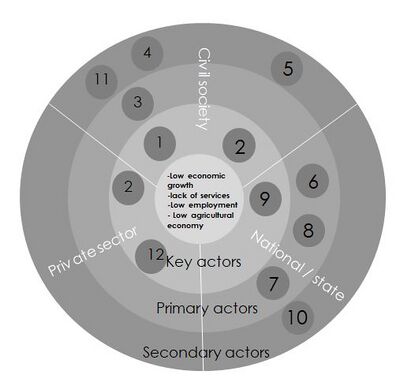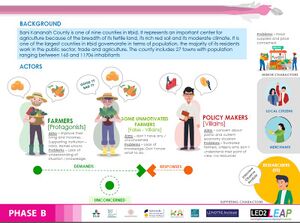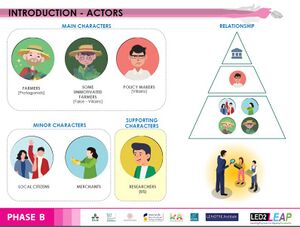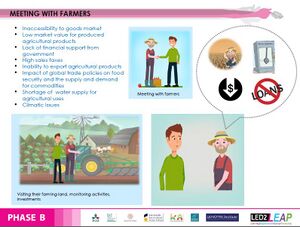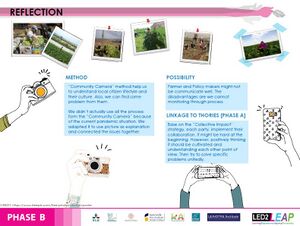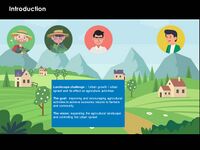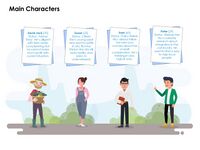LED2LEAP 2020 - Freising Team 8
>>>back to working groups overview
| Area | Bani Knanah County | |
| Place | Irbid City | |
| Country | Jordan | |
| Topics | Agriculture / Rural development | |
| Author(s) | Amal-Kanimozhi-Kamolshanok-Doraed | |

| ||
Landscape Democracy Rationale
- Why do you think this community context is relevant from a landscape democracy perspective? What is your hypothesis considering the landscape democracy challenges?
- It is a rural region with good agricultural land and natural resources. meanwhile, farmers in this community are facing some issues regarding their activities which make it less profitable and force them to live in bad economic situation. these farmers are not involved on the policy making process. which make the national or state policies to play a negative role in their community
Location and scope
- The Location is located in Jordan.
- Our main focus area is the Bani kinanah county, Irbid City.
Phase A: Mapping your Community
Welcome to your community and its landscape
Bani Kinanah County is one of nine counties in Irbid. It represents an important center for agriculture because of the breadth of its fertile land, its rich red soil and its moderate climate. It is one of the largest counties in Irbid governorate in terms of population, the majority of its residents work in the public sector, trade and agriculture. The county includes 27 towns with population ranging between 165 and 11706 inhabitants The county is an extension of three types of terrains; plain, mountain and valley. Its land is considered as one of the richest agricultural lands in the country where it produces about 11% of total olives productions in Jordan.
Groups of actors and stakeholders in our community
1- smallholder farmers : Involved in Small agricultural businesses / local trading or family consumption .
2- stakeholder farmers who are involved in large agricultural businesses / importing and exporting agricultural products & Agro-industrial businesses(like olive oil production) / local and international trading.
3- Jordanian Farmers union: Group of people from the civil society involved in the issues of the agricultural sector.
4- commuters Rural-Urban job commuters
5- local workers : people who have a job inside the county in the private or public sector .
6- King Abdullah fund for development: involved in the development and supporting of small and medium economic projects for people who don’t have a decent job. (Governmental organization).
7- Woman microfinance fund association : involved in the development of improving the socio-economics of women.
8- International NGO’s : involved in infrastructure development , economic development and refugees.
9- policy makers National policy maker (such as ministry of transportation / ministry of economics/ Ministry of agriculture) State policy makers (Greater Irbid Municipality ) Local policy makers
10- Local authorities / municipalities: involved in the monitoring and development.
11- Refugees
12- investors in tourism sector : local and national investors in the historical sites and natural resources in the region .
Relationships between your actors and groups
Summary of your learnings from the transnational discussion panel on April 22
On April 22 you will present the PPT version of this first assignment to other seminar groups working in other geographical community contexts. Please give here a short summary of your learnings during this presentation, for example:
- Other analytical approaches
- Other representation styles
- Other value schemes: any surprises?
- Constructive comments we received on our presentation
Theory reflection
Focusing on the topics about poverty and economical developments, how to improve and integrated idea as proposal to the community.
Evolving liabilities of income by promoting agricultural and attraction sectors.
Indicated our main group of users as first priorities which are mainly farmers, local worker.
Difficulties:
Unable to access the community by ourselves, we worked based on collected information and assumption of how it will affect. In the region, almost all communities have the same evaluation and value with small differences. Have to assuming and eliminating some minor issues.
Reading / Theories relations:
Landscape based on economy : agricultural economy – farmers, workers. All interrelated to private and public sectors Stories behind cultural and historical Landscape. Change of Time related to quality of living. Feedback loop for planning, observing , monitoring action and reflection.
References
- give a full list of the references you have used for this section
Phase B: Democratic Landscape Analysis and Assessment
The Scene in your Story of Analysis
The Actors in your Story of Analysis
The Story of Analysis
Reflect on your Story of Analysis
Phase C: Collaborative Visioning and Goal Setting
The Scene in your Story of Visioning
- Landscape challenge : Urban growth / urban sprawl and its effect on agriculture activities
The goal: improving and encouraging agricultural activities to achieve economic returns to farmers and community
The vision: expanding the agricultural landscape and controlling the urban sprawl
The Actors in your Story of Visioning
- Uncle Jack [35]
Status : Farmer Story : He’s diligent with farm works. Love farming. But he cannot make much profit with current situation.
Susan [25] Status : Citizen She’s young adult who want to settle in city. But she think in the city still lacks facility and seem to undeveloped.
Sam [45] Status : Policy Maker He’s always follow the rules and concern about the overall consideration. He’s thinking in very logical way.
Peter [29] Status : Researcher He’s currently research about integration in the community. He want to find a way to help local people.
John [20] Status : Uncle Jack’s nephew -Farmer Story : He’s only do his tasks. He’s also lack motivation to improve his skill.
Janie [32] Status : Citizen She has a big family and like to spend time with them in the park and walking at streets. She want more green space.
Ken [30] Status : Merchant / Seller He’s really talkative. He’s also the best seller in town. He want more products from farmers.
The Story of Visioning
- Describe the crux of the story. How did the actors engage in collectively developing the goals, and what was the process involved in prioritizing them? Slide 1
- What is the visualization, the actual vision, that expresses the synthesis of these prioritized goals? Slide 2
- What is the strategy that was built for attaining one of these goals, the three year plan of action? Slide 3
- add the corresponding visual from your presentation to the image gallery below
- Yourcase Story 1.jpg
add a caption
- Yourcase Story 1.jpg
add a caption
- Yourcase Story 1.jpg
add a caption
Reflect on your Story of Visioning
- What points were most important when formulating goals and what are the common characteristics of a good vision?
- add the corresponding visual from your presentation to the image gallery below
- Yourcase refelction1.jpg
add a caption
Phase D: Collaborative Design, Transformation and Planning
* template coming
Phase E: Collaborative Design, Transformation and Planning
* template coming
= Phase E: Collaborative Evaluation and Future Agendas * template coming
Process Reflection
- Reflect in your intercultural and interdisciplinary team on the outcomes of your study
- Which limitations were you facing?
- What have you learnt from each other?
- What would you do differently next time?
- You can also use diagrams/visuals
- 250 words text


